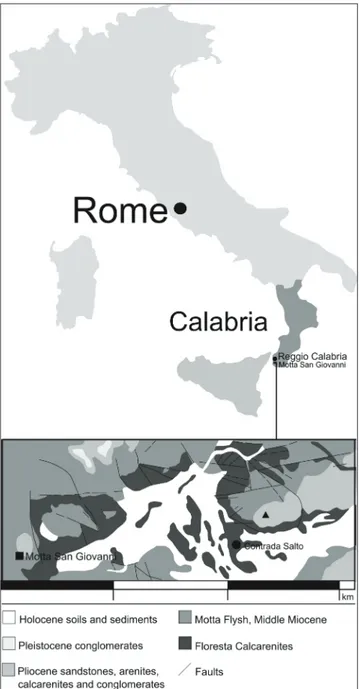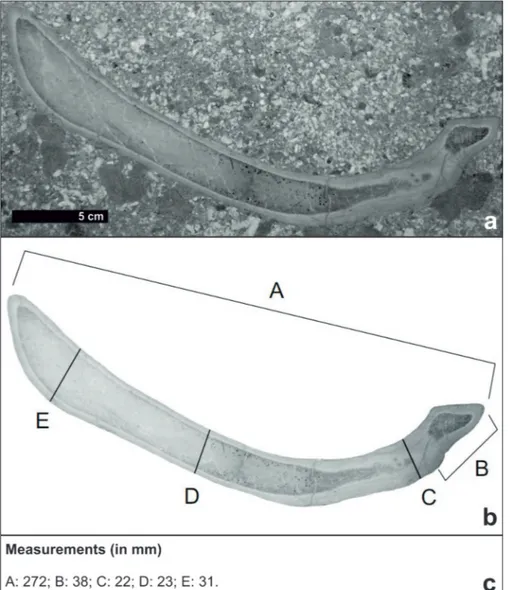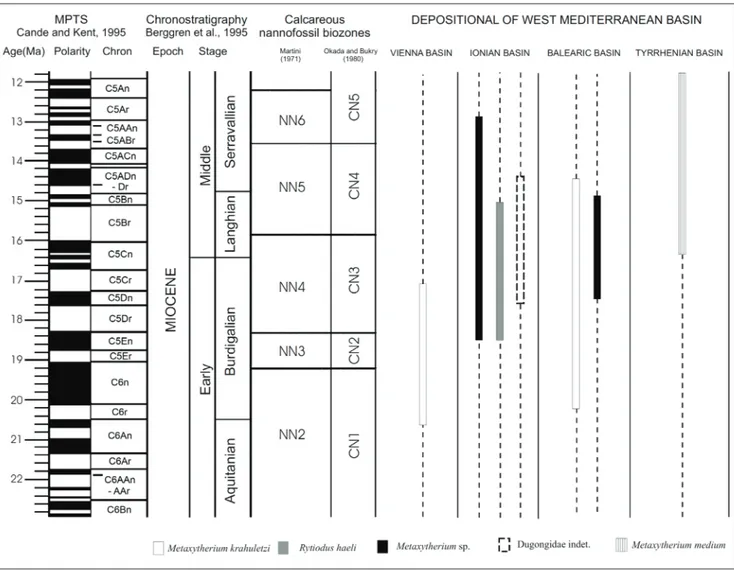FIRST RECORD OF DUGONGIDAE (MAMMALIA: SIRENIA) FROM THE FLORESTA CALCARENITES FORMATION (LATE BURDIGALIAN–EARLY LANGHIAN,
REGGIO CALABRIA, SOUTHERN ITALY)
GIUSEPPE CARONE1, ANTONELLA CINZIA MARRA2 & CATERINA MESIANO3 1Museo Civico di Ricadi (MURI), via Roma, 89861 Santa Domenica di Ricadi (VV), Italy. E-mail: [email protected]
2Dipartimento di Scienze Matematiche e Informatiche, Scienze Fisiche e Scienze della Terra, Università degli Studi di Messina, Viale F. Stagno
D’Alcontres 31, 98166 Messina, Italy. E-mail: [email protected]
3Museo di Paleontologia e Scienze Naturali del Parco dell’Aspromonte, Bova, Reggio Calabria, Italy.
To cite this article: Carone G., Marra A.C. & Mesiano C. (2016) - First record of Dugongidae (Mammalia: Sirenia) from the Floresta Calcarenites Formation (late Burdigalian-early Langhian, Reggio Calabria, Southern Italy). Riv. It. Paleont. Strat. 122(1): 1-6
I
ntroductIonA rib referable to the Family Dugongidae has been recorded in the “Floresta Calcarenites” For-mation cropping out at Motta San Giovanni, near Reggio Calabria (southern Italy; Fig.1). Calcarenites are locally named “Pietra di Lazzaro” and used as decorative stones.
The specimen was recovered during the cut of a block from a quarry located at “Contrada Sal-to”, near Motta San Giovanni (Reggio Calabria), 650-670m a.s.l., 38° 0’ 1.035” N, 15° 42’ 59.923” E.
Although the rib is not a diagnostic bone for taxonomy, its discovery is relevant to the distribu-tion of Dugongidae in the Mediterranean Basin during the late Burdigalian-Langhian (late Early to Middle Miocene) and dates back the Sirenians’ re-cord of Calabria.
G
eoloGIcal settInGThe “Floresta Calcarenites” Formation crops out in the Calabria-Peloritani Terrane (CPT),
loca-ted at the intersection between the NW/SE-tren-ding southern Apennines and the SE-trenNW/SE-tren-ding Sici-lian Maghrebides. During the Early Oligocene, the CPT resulted from the emplacement of a fragment of the European margin onto the African paleo-margin. The CPT lies on a Serravallian substratum and two superimposed tectonic units are present: “Sicilide” Unit, lower sequence of flyschioid de-posits, variegated sandstones and andesitic tuffites; “Calabride” Unit, upper sequence of igneous and metamorphic nappes thrust onto the lower unit, with remnants of Meso-Cenozoic covers (Carbone et al. 1983, 2008; Carmisciano et al. 1981; Lentini et al. 1990). The tectonic units are unconformably co-vered by the “Capo d’Orlando” Flysch, late Oligo-cene-early Burdigalian in age (according to Carbone et al. 2008, 2011; Giunta et al. 2013). The “Antisici-lide”, made up of varicoloured clays, overthrust the “Capo d’Orlando” Flysch during the mid-late Bur-digalian (Carbone et al. 1993, 2008). The “Floresta Calcarenites” Formation (FC) lies on the Antisicili-de clays, excluding some localities of eastern Pelori-tani, where it lies directly on the “Capo d’Orlando” Flysch or the crystalline basement (Carbone et al. 1993, 2008, 2011; Giunta et al. 2013). The FC Fm. is locally overlain by the “Motta” Flysch, a siliciclastic succession cropping out in Calabria and attributed Abstract. A sirenian rib has been recovered at Motta San Giovanni (Reggio Calabria) in the “Floresta
Calcare-nites”, a formation cropping out in Sicily and Calabria and dated late Burdigalian-Langhian. Although the rib is not a diagnostic bone for taxonomy, its presence in southern Calabria extends the knowledge about the pa-leobiogeography of the Family Dugongidae in the Mediterranean basin. The find is hitherto the only record of sirenians in the Floresta Calcarenites. Moreover, the specimen extends back to the Early-Middle Miocene (late Burdigalian-Langhian) the occurrence of sirenians in Calabria, previously determined based on substantial mate-rial from the Late Miocene (Tortonian) of the Monte Poro area (Vibo Valentia). The paleoenvironment of the Floresta Calcarenites was a warm and shallow sea, consistent with the paleoecology of Dugongidae.
Received: June 17, 2015; accepted: October 26, 2015
to the Middle Miocene (Barrier et al. 1987).
The FC Fm. occurs in small isolated outcrops in the Peloritani, more frequently, and in the Aspro-monte Mountains, and it is made up of sandstones with abundant calcareous cement and rich in bio-clasts and silicibio-clasts, which can locally be conglo-meratic.
Carbone et al. (1993) consider the scattered outcrops of the FC Fm. as the result of an extre-mely active synsedimentary tectonic regime, which involved the south-verging thrusting.
The calcarenites present two main facies rela-ted to different marine depths (Carbone et al. 1993): 1) shallow water facies, rich in bryozoans and
rho-dolites; deep water facies with mixed siliciclastic ele-ments, related to resedimentation events.
The shallow-water facies is made of pale grey carbonates with reworked bryozoans and coralline algae, interpreted as near in situ packstones deposi-ted on shallow ramp (less than 50 meters under the sea level; Buxton and Pedley 1989; Carbone et al. 1993). It is often overlain by bioclastic carbonates, locally cross-stratified (Carbone et al. 1993). The de-ep-water facies is resedimentated, and may presents graded or massive strata. Carbonate and siliciclastic sediments were well washed before transportation, as indicated by the lack of fine grain matrix, and were deposited flowing down slopes (Carbone et al. 1993).
In the hypotheses sustained by Carbone et al. (1993), the most reliable source of siliciclastic materials is the subaerial erosion of small islands emerged for the strong tectonic activity. During late Burdigalian to early Langhian, these units develo-ped diachronously as a consequence of the com-bined effects of marine eustatism and tectonism. Carbonate packstones rich in bioclasts were formed during a marine highstand in the shallow sea wa-ters around the small islands (late Burdigalian); later the sea level fell and determined the end of carbo-nate deposition; shallower deposits were progres-sively dismantled and resedimentated in adjacent lows (Langhian). During the Serravallian, a marine highstand submerged the small islands and deter-mined the extended deposition of clays in all areas (Carbone et al. 1993).
Lithostratigraphic correlations are very diffi-cult, due to the short persistence of diachronic ba-sins and the scattered distribution of outcrops.
Samples from the section of Monte Bammi-na (near Novara di Sicilia, Sicily) yielded a fauBammi-na of Foraminifera useful for dating. The basal levels have been attributed to the late Burdigalian due to the presence of Globigerinoides trilobus, Globorotalia [recte Paragloborotalia] siakensis, and Globorotalia [recte Para-globorotalia] acrostoma; the upper levels are attributed to the Langhian due to the presence of Globigeri-noides irregularis, Praeorbulina glomerosa glomerosa, and Praeorbulina glomerosa circularis (Carbone et al. 1993).
At “Contrada Salto”, the Floresta Calcareni-tes lie in concordance on the varicolored clays be-longing to the Antisicilide complex. At the bottom, calcarenites lie slightly inclined, while at the top they may locally be cross-bedded. The Floresta
Calcare-Fig. 1 - Geographical location of Motta San Giovanni and geological sketch map of the area.
nites are overlain by Holocene deposits. In the quar-ry, the FC presents the facies of biolithites rich in bryozoans and rhodolites related to deposition in a warm shallow sea. Accordingly to the interpretation proposed by Carbone et al. (1993), the deposition of coralline algal packstones might be attributed to late Burdigalian.
s
ystematIcpaleontoloGyClass mammalIa Linnaeus, 1758 Order Sirenia Illiger, 1811
Family Dugongidae Gray, 1821 Dugongidae indeterminate
Referred specimen: Left anterior rib (MPSNA
unnumbe-red) embedded in matrix sectioned into a slab (Fig. 2).
Locality: Quarry at Contrada Salto, Motta San Giovanni
(Reggio Calabria; 38° 0’ 1.035” N, 15° 42’ 59.923” E).
Formation: “Floresta Calcarenites” Formation. Age: Early-Middle Miocene, late Burdigalian-Langhian.
Repository: The specimen is kept in the collections of
Museo di Paleontologia e Scienze Naturali del Parco dell’Aspromonte (Bova, Reggio Calabria)
Description. The anatomical terminology
and measurements follow Domning (1978). The left rib is embedded in the carbonatic matrix and is preserved in a sectioned slab (Fig. 2a). Because of the commercial use of the calcarenites for floors, the rock and the embedded rib were sliced and pol-ished to obtain a tile. The rib was not exposed, but it were noticed after the cut, as a dense (pachyosteo-sclerotic) bone showing a light brown outline and a dark interior. Descriptions and measurements are done on the bone included in the slab.
The proximal curvature (angle) is very slight; the capitulum is joined to the shaft by a thick neck. The tuberculum seems pronounced and extends up above the level of the neck. A ventral process is not present. The poorly developed articular processes suggest that the rib belonged to a young specimen.
Fig. 2 - Sirenian rib housed at MPSNA: a) specimen in the slab; b) plan of measurements: A - total length; B - tip of capitulum to lateral edge of tuberculum; C - proximal thickness; D - mid-shaft thickness, E - distal thickness; c) measurements.
The bulge in the distal portion of the shaft, and the thick neck, suggest that it is an anterior rib. The dis-tal end tapers slightly to an oval termination, prob-ably rugose, for cartilage attachment.
The rib from Motta San Giovanni does not represent a diagnostic skeletal element that can be taxonomically assigned below the level of Family. Its morphology is consistent with that of the Dugongi-dae, which is the only sirenian Family known from the Mediterranean Miocene. Measurements are within the variability of the Family Dugongidae (Fig. 2b and c).
d
IscussIon andconclusIonsDugongidae is a Family of extinct and living sirenians with a wide geographical and
biostrati-graphical distribution (Tab. 1, Fig. 3).
Fossils of Dugongidae have been collected in several Miocene localities of the Mediterranean re-gion. During the latest Burdigalian-early Langhian, two sirenians, belonging to two distinct Subfami-lies, were present in the Mediterranean Basin (Tab. 1, Fig. 3): Rytiodus heali (Dugongidae, Dugonginae), characterized by broad, mediolaterally-compressed, blade-like tusks with enamel mainly on the medial side, probably specialized as seagrass feeders that used their tusks in excavation of seagrass rhizomes; and Metaxytherium (Dugongidae, Halitheriinae) who-se early and middle Miocene members (M. krahuletzi and M. medium, respectively) were characterized by small tusks and were probably adapted to a genera-lized seagrass diet.
Sirenian remains have been found in the
Lo-Tab. 1 - Representative sirenian re-cords from the western Mediterranean Basin during Burdigalian-Langhian time. Institutional abbreviations: BMNH = Natural History Museum, London, England; MAC = Museo di Storia Naturale Aquilegia, Caglia-ri, Italy; MDLCA = Museo Sardo di Geologia e Paleon-tologia Domenico Lovisato, Università di Cagliari, Caglia-ri, Italy; MPNRL = Maison du Parc Naturel Régional du Luberon, France; MPSNA = Museo di Paleontologia e Scienze Naturali del Par-co dell’Aspromonte, Bova, Reggio Calabria, Italy; MV = Museu de Vilafranca, Vi-lafranca del Penedès, Spain; KME = Krahuletz-Museum, Eggenburg, Austria; NHM-Be = Naturhistorisches Museum, Bern, Switzerland; NMNH = National Mu-seum of Natural History, Mdina, Malta; PU = Museo di Geologia e Paleontologia dell’Università di Torino, To-rino, Italy.
wer Miocene Marada Formation (Jabal Zaltan, Libya); most of these were described as Rytiodus heali, but some represent Metaxytherium sp. as well (Domning & Sorbi 2011). Some fragmentary remains referable to Metaxytherium come also from Malta, Gozo, Apu-lia and Sicily. Therefore in this area dugongines and halitheriines seem to have lived sympatrically.
Due to its morphology and taxonomic signi-ficance, the rib reported here could represent both sirenian taxa.
Nevertheless, the presence of a sirenian rib in the FC Fm. at Motta San Giovanni marks a new occurrence in the geographical distribution of Dugongidae in the Mediterranean area during the Early-Middle Miocene, often represented by scant materials roughly attributable to Dugongidae (Tab. 1).
Furthermore, the specimen represents the first record of sirenians in the Floresta
Calcareni-tes Formation, cropping out in southern Calabria and northeastern Sicily. The FC Fm. is represented by scattered and diachronical outcrops, whose dif-ferent facies are interpreted as different phases of development through time (Carbone et al. 1993). Outcrops referable to pale grey carbonates with reworked bryozoans and coralline algae, like Motta San Giovanni ones, are representative of the first phase of deposition (late Burdigalian) and occur along the modern Thyrrenian coast of NE Sicily and in the southern margin of Aspromonte in Ca-labria (Carbone et al. 1993). These packstones were formed on a ramp in shallow waters, deep less than 50 meters, as indicated by algal and foraminiferal associations, around the small islands emerged for tectonism (Carbone et al. 1993). This environment was favourable to sirenians.
Moreover, it is possible to infer a precise da-ting for the rib, if is accepted the development of
Fig. 3 - Stratigraphic distribution of Dugongidae spp. occurrences in the western Mediterranean basins. Abbreviations: VB, Vienna Basin; IB, Ionian Basin; BB, Balearic Basin; TB, Tyrrhenian Basin.
the FC Fm. facies sustained by Carbone et al. (1993), which consider the carbonatic packstones formed in a first depositional phase, attributable to late Bur-digalian.
This find represents the earliest occurrence of sirenians in Calabria, previously represented only by abundant remains from the Late Miocene (Tor-tonian) of the Monte Poro area, near Vibo Valentia (Carone and Domning 2007).
Aknowledgements. The Authors are deeply indebted to Daryl
P. Domning (Howard University, USA) and an anonymous reviewer for improving the paper with their suggestions, and to prof. Loren-zo Rook (University of Florence) for critical reading. Prof. Renato Crucitti, Director of the “Museo di Paleontologia e Scienze Naturali
del Parco dell’Aspromonte” is acknowledged for his constant activity of fossil’s preservation and for allowing this study. A final mention to Mr. Carmelo Ambrogio (Cea costruzioni srl) for recovering the fossil and depositing it to the Parco dell’Aspromonte Paleontological Museum.
references
Adams L.A. (1866) - On the Discovery of Remains of Hali-therium in the Miocene Deposits of Malta. Quarterly J. Geol. Soc., 22: 595-596.
Barrier P. (1987) - Stratigraphie des dépot pliocène et pleis-tocène du Detroit de Messine (Italie). Doc. Trav. Inst. géol. Albert de Lapparent (IGAL), 11: 59-81.
Berggren W.A., Kent D.V., Swisher C.C. & Aubry M. (1995) - A revised Cenozoic geochronology and chronostratig-raphy. In: Berggren W.A. et al. (Eds) - Geochronology, Time Scales and Global Stratigraphic Correlation. SEPM Sp. Pub.,54: 129-212.
Bianucci G., Gatt M., Catanzariti R., Sorbi S., Bonavia C.G., Curmi R. & Varola A. (2011) - Systematics, biostratig-raphy and evolutionary pattern of the Oligo-Miocene marine mammals from the Maltese Islands. Geobios, 44:
549-585.
Bianucci G., Landini W.E. & Varola A. (2003) - New records of
Metaxytherium (Mammalia: Sirenia) from the late Miocene
of Cisterna quarry (Apulia, Southern Italy). Boll. Soc. Pale-ontol. It., 42(1-2): 59-63.
Bonardi G., Cavazza W., Perrone V. & Rossi S. (2001) - Ca-labria-Peloritani terrane and northern Ionian Sea. In: Vai G.B. & Martini I.P. (Eds) - Anatomy of an Orogen: The Apennines and Adjacent Mediterranean Basins: 287-306. Kluwer Academic Publishers, Dordrecht.
Cande S.C. & Kent D.V (1995) - Revised calibration of the geomagnetic polarity timescale for the Late Cretaceous and Cenozoic. J. Geoph. Res., 100: 6093-6095.
Cañigueral J. (1952) - Un notable sirénido en Mallorca. Ibérica,
(2)16(245): 387-390.
Carbone S., Messina A. & Lentini F. (2008) - Note Illustrative della Carta geologica d’Italia alla Scala 1:50.000 Foglio 601 Messina Reggio di Calabria. Servizio Geologico d’Italia,
APAT, S.EL.CA, Firenze, 179 pp.
Carbone S., Messina A. & Lentini F. (2011) - Note Illustrative della Carta geologica d’Italia alla Scala 1:50.000 Fogli 587 e 600 Milazzo-Barcellona. Servizio Geologico d’Italia. APAT, S.EL.CA, Firenze, 262 pp.
Carbone S., Pedley H.M., Grasso M. & Lentini F. (1993) - Ori-gin of the “Calcareniti di Floresta” of NE Sicily: late orogenic sedimentation associated with a middle Mio-cene sea-level high stand. Giornate di Geologia, 55(2)(3):
105-116, Bologna.
Carone G. & Rizzo R. (In progress) - Miocene sirenian fossils from Sardinia (Italy).
Carone G. & Domning D.P. (2007) - Metaxytherium serresii
(Mammalia: Sirenia): new pre-Pliocene record, and im-plications for Mediterranean paleoecology before and after the Messinian Salinity Crisis. Boll. Soc. Paleontol. It.,
46(1): 55-92.
Domning P.D. & Sorbi S. (2011) - Rytiodus heali, sp. nov., a new
sirenian (Mammalia, Dugonginae) from the Miocene of Libya. J. Vert. Paleontol., 31(6):1338-1355.
Domning D.P. (1978) - Sirenian evolution in the North Pacific Ocean. Univ. California Pub. Geol. Sci., 118: 1-176.
Giunta G., Carbone S., Catalano R., Di Maio D. & A. Sulli A. (2013) - Note Illustrative della Carta geologica d’Italia alla Scala 1:50.000 Foglio 599 Patti. Servizio Geologico d’Italia, APAT, S.EL.CA, Firenze, 222 pp.
Grasso M., Pedley M., Distefano R. & Cormaci C. (1996) - Upper Miocene reefs in southern Calabria: new records from the Palmi and Vibo Valentia areas and their palaeo-geographic and neotectonic importance. Boll. Soc. Geol. It., 115: 29-38.
Gray J.E. (1821) - On the natural arrangement of vertebrose animals. London Medical Repository, 15: 296-310.
Illiger C. (1811) - Prodomus Systematis Mammalium et Avium: Additis Terminis Zoographicus Utriusque Clas-sis, Eorumque Versione Germanica. Sumptibus C. Sal-feld, Berlin, 302 pp.
Linnaeus C. (1758) - Systema Naturae per Regna Tria Natu-rae, Secundum Classes, Ordines, Genera, Species, cum Characteribus, Differentiis, Synonymis, Locis. Tomus I, Editio decima, reformata. Laurentii Salvii, Stockholm, 823 pp.
Martini E. (1971) - Standard Tertiary and Quaternary calcar-eous nannoplankton zonation. In: Farinacci A. (Eds) - Proceedings 2nd International Conference Planktonic Microfossils, (Ed. Tecnosci.) 2: 739-785, Roma.
Okada H. & Bukry D. (1980) - Supplementary modification and introduction of code numbers to low latitude coc-coliths biostratigraphic zonation. Mar. Micropalaeontol.
5(2): 321-325.
Pilleri G., Biosca J. & Via L. (1989) - The Tertiary Sirenia of Catalonia. Brain Anat. Ist.: 1-98.
Sorbi S. (2008) - New record of Metaxytherium (Mammalia,
Si-renia) from the lower Miocene of Manosque (Provence, France). Geodiversitas, 30(2): 433-444.



